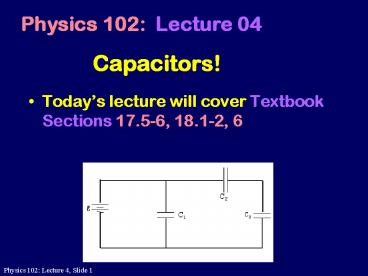Capacitors - PowerPoint PPT Presentation
1 / 19
Title: Capacitors
1
Capacitors!
Physics 102 Lecture 04
- Todays lecture will cover Textbook Sections
17.5-6, 18.1-2, 6
2
Capacitance The ability to store separated
charge CQ/V
Charge Q on plates
Charge 2Q on plates
V VA VB E0 d
V VA VB
E
EE0
- - - - -
- - - - -
- - - - -
A
B
d
d
Potential difference is proportional to charge
Double Q ? Double V Q CV
3
Capacitor
- Any pair conductors separated by a small
distance. (e.g. two metal plates) - Capacitor stores separated charge
- Positive Q on one conductor, negative Q on other
- Net charge is zero
QCV
U (½) Q V
- Stores Energy
4
Capacitance Practice
Example
- How much charge is on a 0.9 F capacitor which has
a potential difference of 200 Volts?
Q
Units?
How much energy is stored in this capacitor?
U
Units?
5
Capacitance of Parallel Plate Capacitor
V
- V Ed AND E Q/(e0A)
- (Between two large plates)
- So V
- Recall C?Q/V
- So C
- (For parallel plate capacitor)
E
-
A
A
If insert dielectric (?gt1) between plates C ?
C0
d
e01/(4pk)8.85x10-12 C2/Nm2
6
Parallel Plate CapacitorC e0A/d
- Calculate the capacitance of a parallel plate
capacitor made from two large square metal sheets
1.3 m on a side, separated by 0.1 m.
Example
C
A
A
Units?
d
e0 8.85x10-12 C2/(Nm2)
7
Dielectric
- Placing a dielectric between the plates increases
the capacitance. - C k C0
8
ACT Parallel Plates
A parallel plate capacitor is given a charge q.
The plates are then pulled a small distance
further apart. What happens to the charge q on
each plate of the capacitor?
1) Increases 2) Constant 3) Decreases
9
Preflight 4.1
A parallel plate capacitor is given a charge q.
The plates are then pulled a small distance
further apart. Which of the following apply to
the situation after the plates have been moved?
1)The capacitance increases
True False 2)The electric field
increases True False 3)The
voltage between the plates increases
True False 4)The energy stored in the
capacitor increases True False
10
Preflight 4.2
Two identical parallel plate capacitors are shown
in end-view in A) of the figure. Each has a
capacitance of C.
B
)
A
)
If the two are joined as in (B) of the figure,
forming a single capacitor, what is the final
capacitance?
1) 2C 2) C 3) C/2
11
Voltage in Circuits
- Elements are connected by wires.
- Any connected region of wire has the same
potential.
- The potential difference across an element is the
elements voltage.
Example
C1
C2
C3
VC1 _____ V
VC3 _____ V
VC2 _____ V
12
Capacitors in Parallel
- Both ends connected together by wire
- Share Charge Qeq Q1 Q2
- Total Cap Ceq (Q1 Q2)/V C1 C2
Veq
- Same voltage V1 V2
C1
C2
13
Parallel Practice
- A 4 mF capacitor and 6 mF capacitor are connected
in parallel and charged to 5 volts. Calculate
Ceq, and the charge on each capacitor.
Example
Ceq C4C6
Q4 C4 V4
Q6 C6 V6
Qeq Ceq Veq
OR Q4 Q6
V 5 V
5 V
5 V
5 V
C4
C6
Ceq
0 V
0 V
0 V
14
Capacitors in Series
- Connected end-to-end with NO other exits
- Same Charge Q1 Q2 Qeq
- Share Voltage V1V2Veq
Q
C1
-
C2
-Q
-
-
15
Series Practice
- A 4 mF capacitor and 6 mF capacitor are connected
in series and charged to 5 volts. Calculate Ceq,
and the charge on the 4 mF capacitor.
Example
Q CV
C4
Ceq
-
C6
-
16
ComparisonSeries vs. Parallel
- Series
- Can follow a wire from one element to the other
with no branches in between.
- Parallel
- Can find a loop of wire containing both elements
but no others (may have branches).
17
Electromotive Force
- Battery
- Maintains potential difference V
- Not constant power
- Not constant current
- Does NOT produce or supply charges, just pushes
them.
-
18
Preflight 4.4
A circuit consists of three initially uncharged
capacitors C1, C2, and C3, which are then
connected to a battery of emf E. The
capacitors obtain charges q1, q2,q3, and have
voltages across their plates V1, V2, and V3.
- q1 q2
- q2 q3
- V2 V3
- E V1
- V1 lt V2
- Ceq gt C1
19
See you next lecture!
- Read 18.4, 6, 8































